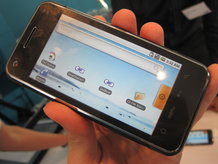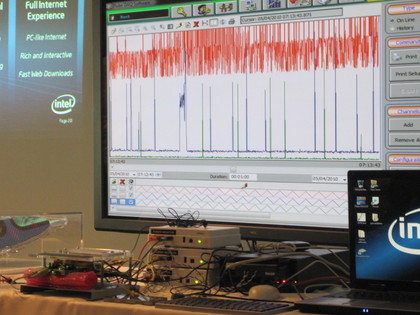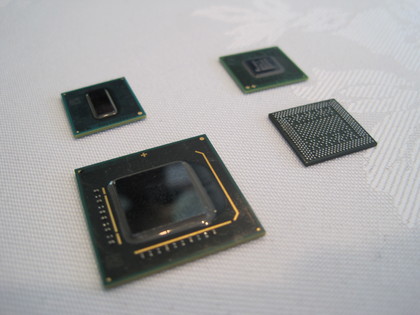Intel announced that its new Atom Z6XX chips, to be sold under the banner of Moorestown, will be powering devices running Android or MeeGo, Intel and Nokia’s new OS that’s sprung from Moblin and Maemo’s loins. Other operating systems will likely be seen using the Z6XX chips, but for now Intel’s only mentioning the two more recent platforms. We can expect to see it in phones, clocking up more than 1.5GHz, thrusting its sword into the throat of the mighty Snapdragon, and when used in tablets or netbooks it could go as far as 1.9GHz.
Crucially, Intel is citing a 50 times power reduction – equating to a 10 day standby time – over the first generation of the Menlow UMPC Atom platform.
Intel was keen to show this with a real-time power consumption demo, shown here. The old Menlow Atom platform is the red line, while the new Moorestown platform is the blue line – both are measurements taken at full stretch. The barely visible green line is Moorestown at idle power.
Intel also demonstrated three-way video conferencing running live on the hardware (encoding one as well as decoding two other streams), as well as Quake 3 and 1080p HD video decoding – the device can encode 720p.
“With these kind of power reductions, we are in the smartphone zone. We are in the game,” said Pankaj Kedia, Intel Director of Mobile Internet Devices. We’ll bring you more from Pankaj Kedia in a separate piece on TechRadar.
Comparisons to other handsets
The smartphone version of the chip will reach 1.5GHz, while a second, tablet-orientated version will ship for tablets.Some graphs were shown comparing the performance of the new Atom to the ARM Cortex-A8 and other unidentified mobile handsets.
While these graphs were convincingly in the Atom’s favour, it was unfortunate that the Cortex-A8 looked at was only clocked at 600GHz and the handsets were unidentified – worth taking with a pinch of salt. Intel also showed graphs claiming a 3-4x JavaScript browsing speed improvement over competitors, though there are so many variables within this it’s hard to take the numbers that seriously until we see shipping devices.
The 140 million transistor SoC (System On Chip) component – is 45nm technology, although Intel was openly looking ahead to producing Atom using the 32nm and 22nm processes.
Intel believes its key advantage is that its architecture is already well established. “It’s a computer that enables voice,” Kedia said of Intel’s hardware, “[It’s] the [level] of experience you expect to find on a PC.”
“If you can deliver great graphics and video, you can scale that up into very slim tablets. We can design where we have to have that discipline up.”
Just to be clear, Moorestown is the platform, As well as the Z6XX variant of the Atom (codenamed Lincroft SoC) also controlling graphics memory and display, the platform includes a Platform Controller Hub (MP20, codenamed Langwell). The platform also includes wireless and other hardware from the likes of Freescale, Ericsson and Marvell, though the exact implementation of this will presumably depend on the handset manufacturer.
Source: TechRadar.






Pingback: Tweets that mention Intel’s New Atom Z6 Mooretown Processors Will Run Android And MeeGo Devices | TheTechJournal.com -:- Technological News Portal -- Topsy.com